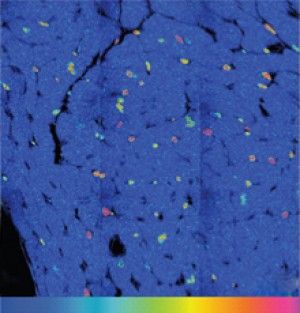Source of New Heart Cell Growth Discovered
Source of New Heart Cell Growth Discovered
A study in mice suggests that new heart cells arise from pre-existing heart cells and that the renewal process slows with age. The findings may lead to improved regenerative therapy for people with heart damage.

Dividing heart cells in newborn mice incorporate a tracer that can be seen in the cells’ nuclei. The color scale at the bottom shows the intensity of the tracer signal, with higher intensity toward the right side. Image by Senyo et al., courtesy of Nature.
The heart’s muscle cells, called cardiomyocytes, don’t readily replenish themselves. So an injured heart isn’t easy to mend. After a heart attack, a significant number of cardiomyocytes die. This jeopardizes heart function and can lead to chronic heart failure and possibly death. To help heal damaged hearts, scientists have been searching for a group of cells in the heart that can replenish damaged tissue.
Recent research has shown that the human heart generates new cardiomyocytes throughout its lifespan, but how frequently the cells are generated and where they come from is still debated. Studying heart tissue and cell turnover rate is technically very challenging. Some research has hinted that new cells can arise from progenitor cells at a fairly high rate. Other work has suggested that pre-existing cardiomyocytes divide at a fairly low rate to give rise to new cells.
A team led by Dr. Richard T. Lee of Brigham and Women’s Hospital and Harvard Medical School applied novel technology to investigate heart cell regeneration in mice. They used a technique called multi-isotope imaging mass spectrometry (MIMS). MIMS can detect nonradioactive stable isotope tracers. In contrast to most other tracers, these don’t alter biochemical reactions and aren’t harmful to the organism.
The scientists incorporated a rare stable isotope of nitrogen, nitrogen-15 (15N), into thymidine—one of the building blocks of DNA. When cells divide, the [15N] thymidine is taken up and added to new DNA. It can then be seen in the cells’ nuclei using MIMS. The work was supported in part by several NIH institutes, including the National Institute on Aging (NIA) and National Heart, Lung and Blood Institute (NHLBI). The study appeared online on December 5, 2012, in Nature.
To study cell turnover at different ages, the scientists gave 3 groups of mice [15N] thymidine for 8 weeks starting at day 4 (newborn), 10 weeks (young adult) or 22 months (old adult). To distinguish which types of cells created new cardiomyocytes, they performed similar experiments in mice genetically engineered with fluorescent tags to mark cardiomyocytes.
The scientists found that new heart cells were generated from pre-existing cardiomyocytes rather than progenitor cells. They estimated a yearly renewal rate of less than 1% during normal, healthy conditions. The rate of cell regeneration, they found, declined with age.
The team next used MIMS to study cell turnover following a heart attack. In the 8 weeks after the damage, roughly 3% of heart cells regenerated in the area next to the injured site. However, the researchers also noted that many cells had taken up 15N but not completed cell division.
“Our data show that adult cardiomyocytes are primarily responsible for the generation of new cardiomyocytes and that as we age, we lose some capacity to form new heart cells,” Lee says. “This means that we are losing our potential to rebuild the heart in the latter half of life, just when most heart disease hits us. If we can unravel why this occurs, we may be able to unleash some heart regeneration potential.”
By Miranda Hanson, Ph.D.
###
* The above story is reprinted from materials provided by National Institutes of Health (NIH)
** The National Institutes of Health (NIH) , a part of the U.S. Department of Health and Human Services, is the nation’s medical research agency—making important discoveries that improve health and save lives. The National Institutes of Health is made up of 27 different components called Institutes and Centers. Each has its own specific research agenda. All but three of these components receive their funding directly from Congress, and administrate their own budgets.




















